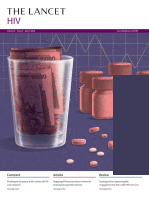Spotlight on SHM research: Incidence of a first venous thrombotic event in people with HIV in the Netherlands

SHM’s data contribute to numerous studies into HIV. In the “Spotlight on SHM data” section, we focus on a recent publication from one of these studies and ask the author about their findings. This time, Jaime Borjas Howard of the University Medical Centre Groningen and Casper Rokx of the Erasmus MC University Medical Centre in Rotterdam discuss their work into the parameters associated with the risk of a first venous thrombotic event in people living with HIV. The research made use of Stichting HIV Monitoring’s ATHENA cohort and was recently published online in The Lancet HIV.
What is new about your study?
People living with HIV seem to be at higher risk of venous thromboembolism (mostly deep vein thrombosis of the legs and pulmonary embolism), mirroring the elevated risk of cardiovascular disease. The reported relative risks vary from a two-fold to even a ten-fold risk of venous thrombotic events (VTE). Interestingly, antiretroviral therapy, and more specifically protease inhibitors, have been implicated in raising the risk of venous thromboembolism. However, although some basic science has suggested this class of medication may be implicated in more active coagulation, the finding could also be due to several biases. Moreover, studies have not been able establish a statistically significant relationship between VTE and declining immune status, which is surprising given the strong relationship between immune status and other adverse events. It is possible that these studies were hampered by a lack of statistical power. Furthermore, they all concern people living with HIV before 2007. Since then, treatment guidelines have evolved, and we therefore expected there to have been a change (most likely a reduction) in the risk of VTE in people living with HIV. We consequently decided to analyse the risk of VTE in people living with HIV in a more contemporary cohort of people living with HIV using data from SHM ATHENA cohort.
Could you briefly summarise the main findings of your paper?
Looking at data collected from 2003 through to early 2015, we found that 232 venous thrombotic events occurred in just under 100,000 years of follow up, yielding an incidence of 2.3 venous thrombotic events per 1,000 person years. Compared with other population studies, this meant that people living with HIV had a two to three times higher overall risk of venous thromboembolism - generally lower than previous literature. However, the risk in those with a normalised immune status (CD4 T-cell counts >500 cells per μl) was closer to that in the general population. This reaffirms the importance of early initiation of antiretroviral therapy (ART) and ensuring effective viral suppression through continuous ART use. Finally, the analysis showed no relationship between any class of antiretroviral medication (including protease inhibitors) and VTE, suggesting that no ART class should be considered contraindicated in people living with HIV with a perceived risk of VTE.
What are your plans for future research?
Using the data from the previous analysis, we are now assessing the risk of recurrent venous thromboembolism in people living with HIV. For this analysis, we are collaborating with the department of clinical epidemiology from the University of Leiden who have been so kind as to supply data of people without HIV as controls to strengthen our analysis.
Reference
Incidence of a first thrombotic event in people with HIV in the Netherlands: a retrospective cohort study
Borjas Howard JF, Rokx C, Smit C, Wit FWNM, Pieterman ED, Meijer K, Rijnders B, Bierman WFW, Vladimir Tichelaar YIG, on behalf of ATHENA observational HIV cohort investigators
The Lancet HIV, published online February 15 2019; DOI:https://doi.org/10.1016/S2352-3018(18)30333-3
Image credit: The Lancet HIV, Vol 6, Issue 3, Cover page, Copyright Elsevier 2019.
